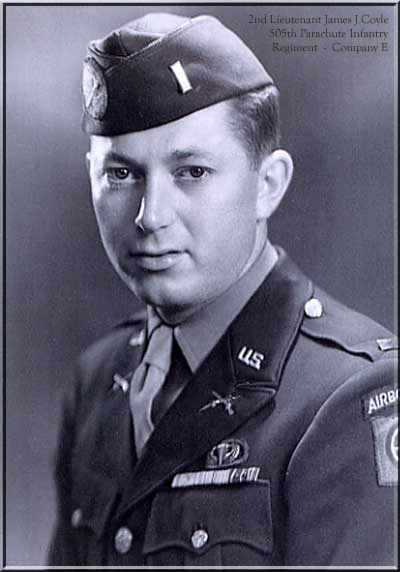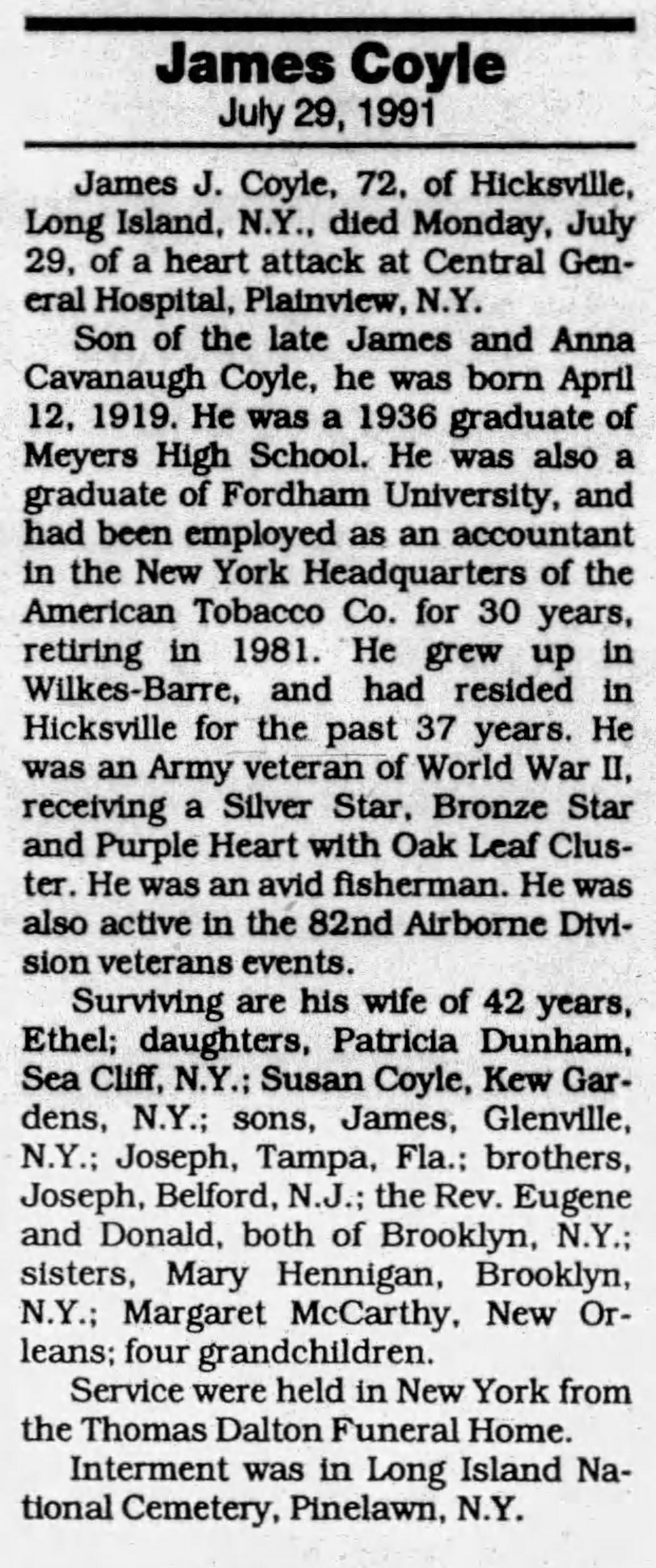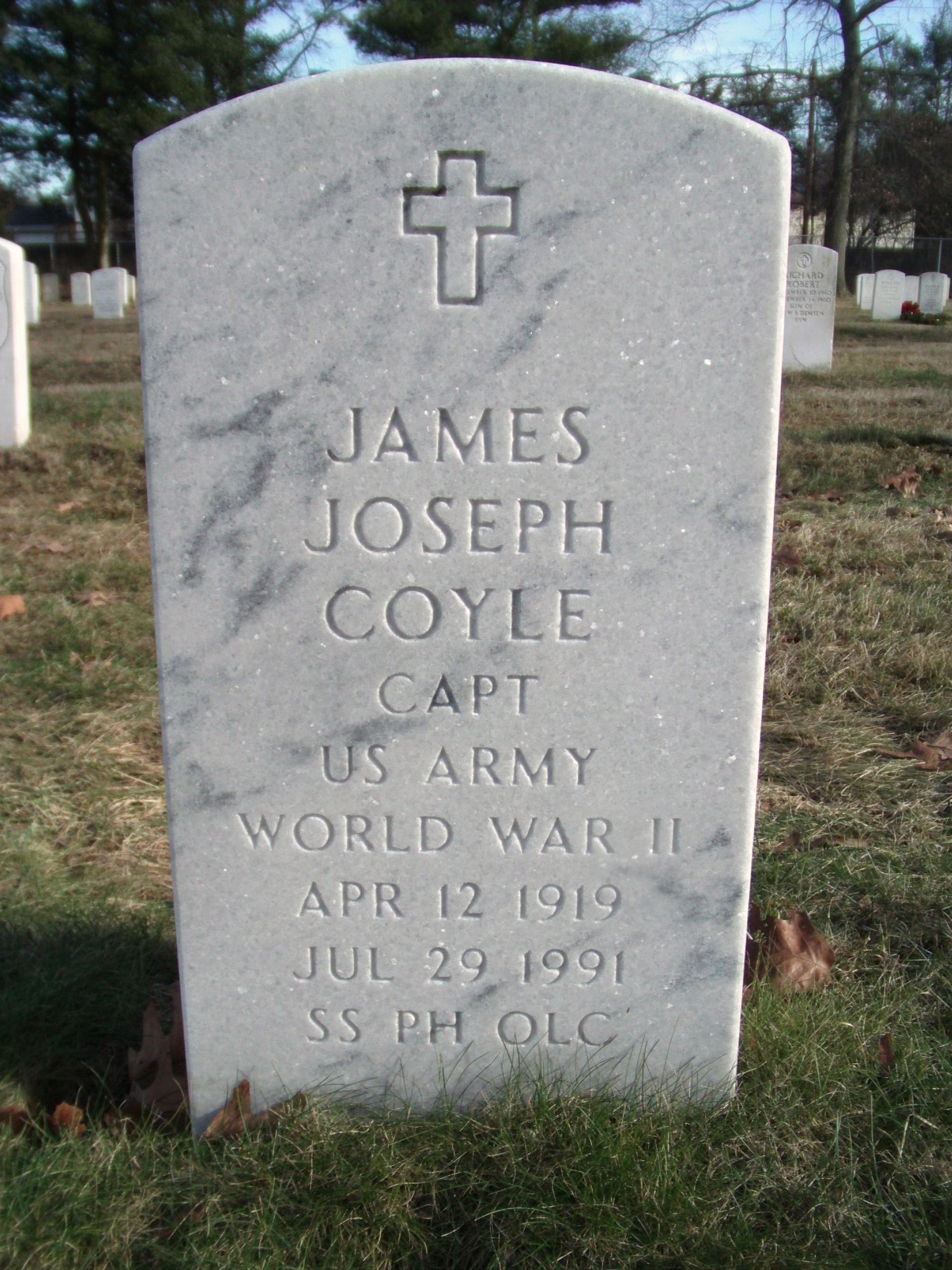
|
|
|
|
|
|
CONTACT US |
|

 |
|
||||||||||||
 |
|||||||||||||
|
|
In January of 1941, James J. Coyle was drafted into the Army from Brooklyn, New York. After basic training, he left for Ft. McClellan, Alabama where he was assigned to the 106th Infantry Regiment of the 27th Infantry Division. With the attack on Pearl Harbor, December 7th 1941, the 106th Infantry Regiment was transferred to the west coast. Two months later they were shipped overseas to the "big island" of Hawaii. At the time of the regiment's arrival it was the only one on Hawaii, they were scattered all around the island's coast in small units. By this time, Private Coyle had been promoted to Sergeant. His squad was stationed on an outpost, all alone, miles from Company Headquarters with only a signal corps field telephone for communications. The 106th had no reserves to speak of and basically served as coast watchers. They shared the Islands with 3 battalions of the 96th Coast Artillery. When higher command realized an invasion wasn't likely, it became easier to transfer out. After Sergeant Coyle had been on the big island for seven months, he received orders to return to the States to attend Infantry Officers Candidate School. Later in the war the 106th Infantry Regiment was shipped to the South Pacific. Read a diary entry describing the conditions at Pearl Harbor the day the 106th Infantry Regiment arrived.

While attending Officers Candidate School, Sergeant Coyle noticed paratroopers jumping on a nearby drop zone on an almost daily basis. Impressed by these fine soldiers, he volunteered for the paratroops as soon as he received his commission. He went directly to Ft. Benning's parachute school in March 1943. He received his wings with class number 61 and was assigned to the 513th parachute regiment. Within a week or two orders came down assigning him to a replacement unit called E.G.B. 447. 2nd Lieutenant Coyle arrived at Camp Shanks, New York where E.G.B.447 prepared to embark over seas. They headed for Staten Island, New York by troop train and boarded the "USS George Washington" bound for North Africa, arriving on May 10th 1943. He was sent to a Replacement Depot near Casa - blanca in French Morocco and boarded a train for Oujda where he was placed in E Company of the 505 Parachute Infantry Regiment. After two months training in the desert of North Africa the regiment left for Kairouan, Tunisia.
*Sicily, Italy 1943*
On July 9th 1943 the 505 Regimental Combat Team boarded C-47's taking them to Sicily. Stiff winds scattered the drop over a wide area. 2nd Lieutenant Coyle stick was dropped 20 miles east of their drop zone landing near the town of Marina Di Ragusa. They entered the town unopposed with no sign of the enemy, they were then ordered to attack a nearby garrison of Italian soldiers. As they approached a shot of honor was fired injuring no one, and without any further resistance several hundred Italian soldiers surrendered.
As E company and the 2nd Battalion headed for Gela, their convoy was strafed by several enemy aircraft wounding three men. From Gela the 505 leapfrogged north through Sicily heading for Trapani on the north west shore. They remained until some time in late August and were flown back to Kairouan in North Africa. E company had seen little action in Sicily with the exception of Sergeant Julius Axman's squad who had engaged a German unit in a fire fight that killed Private Harry C. Downey of Michigan. In another incident while on Sicily 2nd Lieutenant Coyle was injured when the platoon's medic picked up an M-1 rifle and accidently fired a round that ricocheted off of a nearby rock and lodged in his buttocks. Because the bullet expended most of its momentum by ricocheting off the rock first, it kept his wound from being a serious matter. According to Lieutenant Coyle, he did spend the next week sleeping on his stomach.
Back in North Africa, Lieutenant Coyle reported to the medical dispensary suffering from dysentery, jaundice and malaria that he picked up in Sicily. The one - two punch of all three diseases kept him from making the combat jump in Italy on September 15th 1943. While in the hospital, a troop carrier pilot occupied the cot next to James. He told him his troop carrier group had dropped the 505 PIR on Salerno, Italy the night before. Lieutenant Coyle began to worry he would never make it back to company E, but he was still very sick and there was no way he could report for duty. Weeks later, when he began to feel better, two other paratroopers from the 505 joined James and they found their way to the Comiso airfield (in Sicily) hitching a ride on a C-47 to Foggia, Italy (where the British were moving up the east coast of Italy) and then by truck to Naples, Italy where he found E company and reported to Lieutenant Talton Long, the company commander.
*Normandy, France 1944*
On the night of June 5, we took off from the Cottesmore airfield in England. For security reasons we were isolated under strict security for several days prior to the jump. I was the jump master on our C – 47, which carried 18 paratroopers. Our machine guns and mortars were in bundles with parachutes slung beneath the airplanes wings, they could be released from inside the plane when we jumped. The door of the plane had been removed, as I sat by the open door, I watched the moonlight shining on the waves. It was a peaceful prelude to a violent invasion. I can't recall my thoughts as we flew in, however, I recall having a personal concern. We had removed six Fulminate of Mercury blasting caps from our demolition kit because of the danger leaving them packed together with the high explosives in the bundle under the wing's of the plane. I taped a wooden block, with the blasting caps inside, to my left foot. They were very sensitive and I was afraid they might blow up when I hit the ground.
Shortly after we crossed the western coast of the Cherbourg peninsula, the anti-aircraft fire filled the sky. This continued on and off until we reached St. Mere Eglise, (France), but none of the fire came near our plane. When the red warning light came on I gave the order to "stand up and hook up". Then starting from the back of the plane each man gave a parachute check of the man in front of him, all the way down to me. The plane's engines slowed down, but I still could not see the lights which were to be set up by the Pathfinders who jumped earlier in the evening to mark our drop zone. Suddenly as the plane made a sharp left turn, I picked out the blue-green lights in a T formation directly in front of us. Just at that moment the green light beside the door went on, I gave the order to jump and out the door I went !
I had no trouble when landing despite all the equipment we carry. As soon as I got out of my parachute and stood up I saw the green light, which was our Battalion assembly signal, a short distance away. The first paratrooper I encountered was our battalion commander Lieutenant Colonel Benjamin Vandervoort. He asked if I had found my medical aid man but I told him I was alone. At that time, he did not mention that he was injured, but he had broken his leg on the jump and fought for weeks with his leg in a cast. He ordered me to continue to locate my men. This I did for the next hour.
.........To be continued...........
James Joseph Coyle's obituary 1991.
Long Island National Cemetery, Pinelawn New York.

|
|